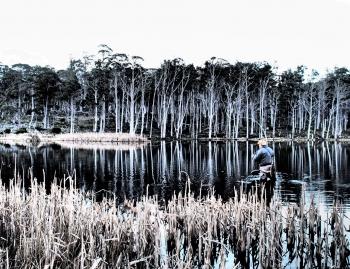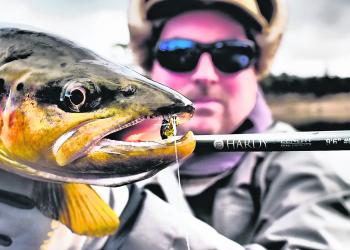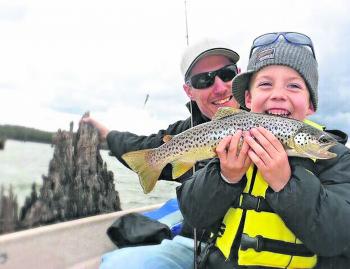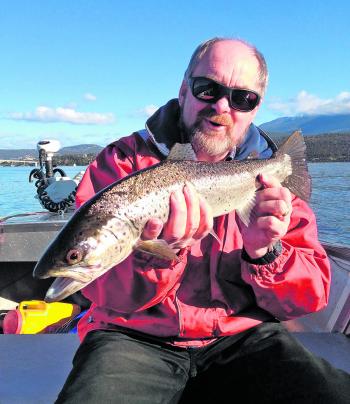Even though it is officially still winter in Tasmania, we do not let this break us for one minute. Steely resolve and a resolute conviction that the sun will burn long and warm once more has us continually reaching for the rod rack when we find the time.
Winter offers many treasures in Tasmania and August can provide mild picturesque days of fishing. It is an exciting month for those that have slowed their fishing due to the cold in the last 2 months. August sees the average temperatures rise by 2ºC!
Ok… probably not the most exciting news we have heard in a while but it is a start. Lovers of longer daylight hours will also be happy that there is 30 more sunshine hours to play with this month. This is a forgotten statistic to some anglers and should have some consideration. In our busy schedules where we are forever trying to find some fishing time, increased day light hours is golden.
While we can rejoice in the fact the weather is improving, we must also be aware of how quickly the weather can change. August is a month you can wake and bounce out of bed to a cloudless sky with some glorious sun and head off for a trip. However, be warned as that day can turn on you like an Asian Sun Bear. Pack for all seasons as that is most probably what you will encounter in a day’s fishing on an August day in Tasmania.
August in Tasmania and it’s all about the trout. It was only last year that we celebrated 150 years of trout fishing in Tasmania. Home sick English dudes who loved to fish, set their minds to the massive task of starting a new fishery on a distant remote isle. On 4 May 1864 after a few failures they had success and the first English trout eggs started hatching at Plenty, Tasmania. It is amazing how this has transpired and now annually 25,000 people fish for trout in Tasmania.
It is easy for local Tasmanian anglers to take our wonderful fishery for granted and forget just how famous Tasmania is for its wild brown and rainbow trout. The wonderful scenery and beautiful clean water also adds to the experience.
What an experience it is. You cannot travel very far at all in Tasmania without finding a stretch of water with the promise of trout. Rivers and lakes and everything in between will provide opportunity to land a trophy fish. The rivers around our larger cities in Launceston and Hobart provide easy access to mainland anglers looking to make the trip.
Just a small drive from the Launceston airport can have you standing on the bank of the South Esk or Macquarie rivers. A rest overnight and a scenic two hour drive to the Central Plateau will have you in a trout fishers wonder world. There are a fantastic range of waters, styles and techniques to take your fancy. The artificial lakes such as Arthurs and Great Lake are the most popular lake fisheries.
The more adventurous angler will look to take in the satisfaction of hunting the wild trout of the Western Lakes. This amazing area is within the Central Plateau World Heritage Area, and is made up of more than 3000 lakes, ponds and tarns. The area is as harsh as it is spectacular and the fishing is rewarding and adventurous.
Flying into the capital of Hobart is also popular with easy access to the Derwent and Huon rivers. These two magical waterways are easy targets and exploring in and around their tributaries will eat up many hours of rewarding angling. If you are looking to make a designated trip with plenty of planning or just a business trip and thrown in a travel rod and a few lures together. Tasmania will not disappoint and you have every chance of bagging a fat, fit trout. A fish of a lifetime.
It’s a mark on the freshwater angler’s calendar that is cemented in place in a way that is almost religious. For some it is an annual pilgrimage to a shack that has been in the family for generations. Time to spend with family, uncles and grandparents and wet the occasional line should weather permit.
Others, like the hardcore trout tragics, will have none of that. They would have been gearing up for the last couple of months. Checking tackle and buying the next ‘killer lure’ ready to launch an all-out assault on the trout population of their favourite opening weekend waterway. Then there are all those in between, just happy to be out and about and sharing a few laughs with some mates and family.
Opening weekend and all of August is a great time to drown a worm in a flooded section of river or slow moving backwater. If I cast my mind way back, this would be my first ever recollection of fishing with a solid glass rod, inexpensive reel and a float. So if you have kids, this can be an inexpensive day out and a great excuse to drag the kids from the iPad. It is an adventure from start to finish.
Getting the kids outside and into the open air is made much easier at the mention of gumboots. They love gumboots as wearing them gives them licence to stand in puddles and walk through the brownest and goopiest of mud. This is hugely important as you will need some trick to motivate the tribe if you want to escape the house and growing list of chores and go for a fish. Stalking skittish trout with kids in tow is not always the best way to catch a few for the pan, but it will score you some serious brownie points.
The adventure starts with locating and collecting the bait and for trout in August we all know that is worms. Turning over a few bits of wood or digging in the garden will take up an hour, but by then they will have worn off some of their cabin fever and enjoyed collecting enough bait for the day’s fishing. The next dilemma to deal with will be the fight over who gets the front seat, but you can offset that with bargaining who is next to hold the glass jar of worms with the holes in the lid.
Just for the record, if you do happen to come across an area like that, well done – you’ve found a leopard print unicorn (doesn’t exist).
What you will be treated to over the next 2 hours, or longer if you are an actual saint, is a fishing heptathlon. The afternoon will consist of the baiting of hooks, casting of line, untangling line and dealing with snacks. Contending with snags and the inevitable re tying of a simple bait rig. You will need the skill, stamina, poise and concentration of a NASA engineer. This will hopefully culminate into the penultimate event and see you put into the bottom of the net a fish your son or daughter has caught.
The smile and excitement and life long memories you have just created will have been worth the pain. The stories they will tell and the interest and pride you have generated is as solid as any gold medal.
The weather in August is still for the hardy but there is so much starting to happen that even the most pessimistic of anglers get a glint in the eye. None more so than the sea runner clan, drunk on the promise of finding big silver-sided trout trying to gorge themselves on whitebait.
It can be a confusing discussion as the term whitebait can mean many different things to many different people from around Australia or indeed the world. This stems from the generic word and its use to describe a collection of lots of immature fry or itty bitty baby fish. In Tasmania the term whitebait is a collective name for small transparent native fish that migrate from the sea in to.
We have a few species that can confuse: whitebait (Lovettia sealii), jollytail (Galaxias maculatus), climbing galaxias (Galaxias brevipinnis), spotted galaxias (Galaxias truttaceus), Tasmanian mudfish (Neochanna cleaveri) and Tasmanian smelt (Retropinna tasmanica). Most whitebait are juveniles, with the exception of Lovettia sealii which are mature adults migrating to spawn.
These little chaps are between 25-50mm long and travel in big schools along our coastline and at this time of year start to head up our estuaries and into our river systems. They have a season and fishery all of their own that starts in October when they really thicken up. The mystique and fascination with catching whitebait is derived from being seen as a delicacy and they are well sought-after and a good whitebait patty is a thing of legend.
Great news for anglers is trout love to feed on these critters just as much as the guys that put them in fritters. Big wise powerful resident trout as well as the nomadic sea run trout will hunt them and gorge themselves on the schools. Often a fish that has been caught this time of year will have whitebait spilling out of them as they have been eating so much of them.
The trout anglers who have had to reduce their area of battle, due to the closed season, can plan an attack on the much sought-after sea run trout on a much bigger field of battle. The upper reaches of all the rivers that see an annual spawning run of whitebait are now fair game and well worth a look.
The water movement and differing speeds of water flow are what the switched on angler is looking for. There are subtle pockets of water where the little whitebait stall or get held by water pressure and these are the places to try and locate. It may be the shape of the bottom, a certain rock or the certain way a bend in the river shapes the flow. This is where the powerful sea runner will look to ambush his dinner.
Rivers that flow into Bass Strait have a lot of tidal flow and at times of heavy water movement downstream the whitebait will be hard up against the edge. The conga line of bait will be swimming its little hearts out, in and around downed logs and the overhanging trees trying to avoid big steely fish.
While most forms of fishing has a very visual side to it, so does fishing for trout when the whitebait are on. Sneaking about a shoreline trying very hard not to spook even the possibility of catching a nice runner there will be a visual explosion of bait breaking the surface and heading every which way. The instant that happens the heart rate will rise as you just know there is a trout hard up there clacker looking to feed on them.
Keep an eye out for big bow waves as fish push bait up into the shallows as well.
The cooler temperatures of August will not excite the ardent of dry fly fishers as any self-respecting insect will have laid its eggs and took off or turned its toes up and died. Don’t despair as the humble black beetle may be your saviour here so nicely tied representations of those presented in the right environment will see some success.
This time of year is more about the big wet flies and it is their time to shine. There is a general rule of thumb that at this time of year the lower altitudes fish better, but I don’t necessarily agree. The brown trout have spawned and will be famished, swimming around looking to smash anything you put in front of them. Rainbow trout will still be looking to spawn and nail your presentation out of aggression.
This is great news for those guys that have not quite got their fly tying perfect. You can plop a star spangled woolly mess out in front of a big rainbow and it may take a swing at it out of disgust. Rabbit fur flies or anything looking to imitate a tad pole or frog will be your friend.
Look for those lakes that have managed to maintain their levels as tailing trout in the flooded margins provides great sport and awesome sight fishing. Little Pine is an example with a shrimp pattern.
The weather will be tricky and often windy and cold and I think this is why people prefer to target the lower altitudes. Those that gear up correctly and have equipment to battle the weather will find substantial reward.
Once the opening season venue has been discussed and settled the next conversation is normally the hotly contested gun lure of choice. It is the sort of question that provides lots of fun and mischief. I have been on opening weekend trips where boats have returned to the ramp after a successful day with lures cheekily covered like an Americas Cup winged keel. One mate of mine would purchase and have in his tackle box a few outrageous looking lures to tie to his line aimed to confuse and befuddle.
Local tackle retailers are the place to go for the up to date info on what you can catch in an area that store operates in. It is invaluable information that they will happily share and even show you some slight technique variances that turn a good lure into a great one. You just don’t get that from an online outlet.
Rodney Howard has been involved in the tackle industry for a great many years. Loves his fishing and gets away to hone his skill, craft and knowledge as much as work can possibly allow. Work for Rodney is as owner and manager of Tassie Tackle and Outdoor. This store has long been held as a premier destination for not just anglers but for anyone looking to take on the great outdoors and all the conditions Mother Nature can throw at you. Well stocked and well-staffed Tassie Tackle and Outdoors has all the quality equipment and advice for anyone looking to catch a fish in Tasmania and around the world.
Rodney and his team not only have experience with Tasmanian species, but with many national and international trips under their belts can set you in the right direction on most species. Here are a few of the lures Rodney has for the start of the trout season and he leans towards lures that allow the angler to cast easily and cover more water.
Lures and flies
Lakes: Nils master 7 cm #67 (good West Coast Lakes), Cobra (frog colour), Ashley Spinner #29 (black/gold).
Rivers: Wonder Wobbler (redfin or greenfin), Smiths Wobbler (black with red spots) Johnson #14 spinner.
Flies: Mrs Simpson, Black beetle (wet), Yeti.
Reads: 2365
Silver grey winters days can offer fantastic trout opportunity.

Tasmanian trout are part of our tradition.

Make sure you pick your spot wisely when fishing with kids. It can make or break the day.

Everyone loves a Derwent runner.

Rug up and be rewarded.

The zany staff at Tassie Tackle and Outdoors have everything you need to find some fish.




